South Indian culture
| Part of a series on |
| Dravidian culture and history |
|---|
 |
|
History |
|
Regions
|
|
People |
| Portal:Dravidian civilizations |
South Indian culture refers to the culture of the South Indian states of Tamil Nadu, Karnataka, Kerala, Andhra Pradesh and Telangana. South Indian culture though with its visible differences forms an important part of the Indian culture. The South Indian Culture is essentially the celebration of the eternal universe through the celebration of the beauty of the body and motherhood.[1][2][3][4][5] It is exemplified through its dance, clothing, and sculptures.[1][2][3][4][5]
Traditional clothing
South Indian women traditionally wear the saree while the men wear a type of sarong, which could be either a white dhoti or a colourful lungi with typical batik patterns. The saree, being an unstitched drape, enhances the shape of the wearer while only partially covering the midriff. In Indian philosophy, the navel of the Supreme Being is considered as the source of life and creativity.[1][2][3][5] Hence by tradition, the stomach and the navel is to be left unconcealed, though the philosophy behind the costume has largely been forgotten.[1][2][3][4][5] This makes the realization of sharira-mandala, where in Angikam bhuvanam yasya (the body is your world) unites with the shaarira-mandala (the whole universe), as expressed in the Natyashastra.[1][2][3][4][5] These principles of the sari, also hold for other forms of drapes, like the lungi or mundu or panchey (a white lungi with colourful silk borders in kannada), worn by men.[6] The lungi is draped over clockwise or counterclockwise and is tied at the back or fixed just along the waist line. It's sometimes lifted to the knee and tied at the waist leisurely or just held in hand to speed up walking.
Traditionally, South Indian men do not cover their upper body. Sometimes, in a formal situation, a piece of cloth may cover the upper body. Certain temples in South India even ban men from wearing upper-body garments when inside the temple. In Andhra and parts of north Karnataka men wear kachche panchey where it is tied at back by taking it between legs. A similar pattern is seen in women. All over the peninsular coastal region men wear coloured lungis and women wear saris in a manner of tying them at the back.
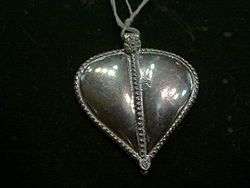
The Araimudi (araimuti) (Tamil: அரைமுடி, araimūḍi ?) is a small silver metal plate, shaped like a heart or a fig leaf, formerly worn by young Tamil girls on their genitals.[7][8][9] "Arai" means loin and "mudi" means cover.[10] The araimudi is also known as the "Genital shield" and an araimudi was mentioned in the "Guide to the principal exhibits in the Government Museum, Pudukkottai", by M. S. Chandrasekhar, published in 1966 as being displayed in an exhibit in the Madras Government Museum.[11] "A Manual of the Salem district in the presidency of Madras, Volume 1" said "The children sometimes, to the age of ten years or more, go in a state of nudity, relieved perhaps by a piece of string round the waist which sustains the "araimudi" or heart-shaped piece of silver, which calls attention to what it purports to conceal."[12] The "Madras district gazetteers, Volume 1, Part 1" said 'Little girls, up to the age of about 3, wear nothing but the little heart-shaped piece of silver suspended by a waist-cord (arai- mudi) " which calls attention to what it purports to conceal."'[13] "Percival's Tamil-English dictionary", edited by P. Percival defined Araimudi as "அரைமுடி arai múḍi, A small plate of gold or silver, appended to the girdle of female children, for the sake of decency".[14] Miron Winslow's dictionary, "A comprehensive Tamil and English Dictionary of High and Low Tamil" defined araimudi as "அரைமுடி, s. A small plate of metal worn by little girls over the private parts."[15][16] Abbe Dubois's book "Hindu manners, customs and ceremonies", translated from French and edited by Henry Beauchamp stated that "Even the private parts of the children have their own particular decorations. Little girls wear a gold or silver shield or codpiece on which is graven some indecent picture ; while a boy's ornament, also of gold or silver, is an exact copy of that member which it is meant to decorate."[17][18][19][20][21][22][23] "Description of the character, manners, and customs of the people of India; and their institutions, religious and civil", also written by Dubois said "The children of either sex are likewise ornamented with various trinkets of the same form, though smaller than those of grown persons. They have also some that are peculiar. As all children in India go perfectly naked till they are six or seven years old, the parents, of course, adapt the ornaments to the natural parts of the body. Thus, the girls have a plate of metal suspended so as to conceal, in some measure, their nakedness. The boys, on the other hand, have little bells hung round them, or some similar device of silver or gold, attached to the little belt with which they are girt. Amongst the rest, a particular trinket appears in front, bearing a resemblance to the sexual part of the lad."[24] Until the 1960s in the Ampara District of Sri Lanka girls wore the Araimudi.[25][26]
Cuisine

Rice is the staple diet, with fish being an integral component of coastal South Indian meals. Coconut is an important ingredient in Kerala and coastal part of Karnataka of South India, whereas the cuisine in Andhra Pradesh is characterized by the delicious pickles, spicy aromatic curries and the generous use of chili powder. Dosa, Idli, Uttapam etc. are popular throughout the region. Coastal areas like the state of Kerala and the city of Mangalore are known for their seafood. South Indian coffee is generally quite robust, and coffee is a preferred drink throughout the Malabar region.Tamil Nadu is well known for its idli,dosai,pongal,sambhar,vadai, puri,which is the common breakfast in Tamil families.
Music
There is a variety of music. It ranges from rural folk music to the sophisticated Indian Classical Music of South India is known as Carnatic music (after Carnatic, the name by which south India was known in the earlier colonial days. Sarang Dev coined south Indian classical music as karnatic Music). It includes melodious, mostly devotional, rhythmic and structured music by composers such as Purandara Dasa, Kanaka Dasaru, Tyagaraja, Dikshathar, Shyama Sasthri, and Swati Tirunal. It is difficult to discuss the culture and music of the four states of South India in a single breath. In Tamil Nadu, there is Tamil Pann, which is sung by Oduvars in Temples. They sing the works of famous Tamil Poets like Sambandar, etc. in various panns (another word for raagas).
Hindu Temple Music
The main instrument that is used in south Indian Hindu temples is the nadaswaram. It is said to have been created when the very first temple was established in South India. The nadaswaram and the thavil were played together in South Indian temples to create a periya melam ensemble. Because of its harsh tone, periya melam is not favored by many Europeans, but to South India, it is a sound of pride and majesty. For many temple traditions, periya melam is necessary for worshippers to feel a spiritual presence. Periya melam is used to play for daily rituals inside the temples and annual rituals outside and around temples.[27]
Dance
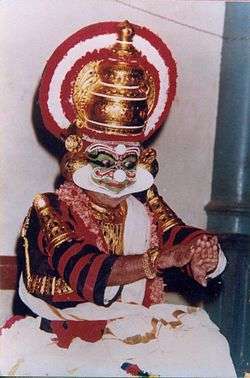
The South Indian culture is celebrated in the elaborate dance forms of South India - Koodiyattam, Bharatanatyam, Oyilattam, Karakattam, Kuchipudi, Kathakali, Thirayattam, Theyyam, Bhuta Kola, Ottamthullal, Oppana, Kerala Natanam, Mohiniaattam and Yakshagana. The Bharatanatyam is the celebration of the eternal universe through the celebration of the beauty of the body.[1][2][3][4][5] This is done through its tenets of having a perfectly erect posture, a straight and pout curving stomach, a well rounded and proportionate body mass- to the body structure, very long hair and curvaceous hips.[1][2][4] These tenets bring to life the philosophy of Natyashastra, ‘Angikam bhuvanam yasya’ (The body is your world).[1][2][4] This is elaborated in the araimandi posture, wherein the performer assumes a half sitting position with the knees turned sideways, with a very erect posture. In this fundamental posture of the Bharatanatyam dance, the distance between the head and the navel becomes equal to that between the earth and the navel. In a similar way the distance between the outstretched right arm to the outstretched left arm becomes equal to the distance between the head and the feet, thus representing the "Natyapurusha", the embodiment of life and creation.[1][2][4]
Architecture and paintings
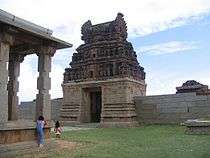
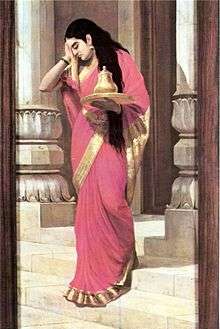
South India boasts of having two enchanting styles of rock architecture, the pure dravida style of Tamil Nadu and the Vesara style (also called Karnata dravida style) present in Karnataka. The inspirational temple sculptures of Mahabalipuram, Tanjore, Hampi, Badami, Pattadakal, Aihole, Belur, Halebidu, Lakkundi, Shravanabelagola, Madurai and the mural paintings of Travancore and Lepakshi temples, also stand as a testament to South Indian culture. The paintings of Raja Ravi Varma are considered classic renditions of many themes of South Indian life and mythology. There are several examples of Kerala Mural paintings in the Mattancherry Palace and the Shiva kshetram at Ettamanoor. South India is home, as of April 2006, to 5 of the 26 World Heritage listed sites in India.[28]
Sculptures and figurine
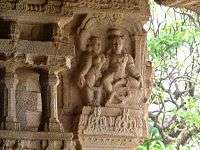
Sculptures became one of the finest medium of South Indian expression after the human form of dance. In this medium it was possible to etch the three-dimensional form in time. The traditional South Indian sculptor starts his sculpture of the divinities from the navel which is always represented unclothed by the sari. A koshta or grid of the sculpture would show the navel to be right at the centre of the sculpture, representing the source of the union of the finite body and the infinite universe. Sculptures adorn many of the temples around the complexes and also inside them. They are also depiction of dance steps of various stylizations and have served to preserve dance forms and revive it.[3]
Literature and philosophy
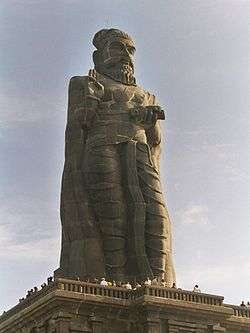
South India has a literary tradition reaching back over two thousand years. The first known literature of South India are the poetic Sangams, which were written in Tamil around two to one and a half thousand years ago. The Kannada classic Kavirajamarga, written in 850 CE by King Amoghavarsha I, makes references to Kannada literature of King Durvinita in early sixth century CE. Tamil Buddhist commentators of the tenth century CE, Nemrinatham makes references to Kannada literature of fourth century CE Distinct Malayalam and Telugu literary traditions developed in the following centuries. The artistic expressions of the South Indian people shows their admiration of the magnificence of nature and its rhythms. Some of the works include Silappadhikaram by Ilango Adigal, Tholkappiam written by Tholkappiar, Thiruvalluvar’s Thirukural and Kumaravyasa's Karnata Bharata Katamanjari and Pampa's Vikramarjuna Vijaya "Andhra Maha Bharatamu" by the three poets namely Nannaya, Tikkana and Errana, and Shiva Sharana's like"'Basavanna's'' andAKKA MAHADEVI's "VACHANA'S". In South Indian literature and philosophy, women are considered very powerful. A married woman is regarded as auspicious, her shakti or mother-feminine power, protects and empowers her husband and their children. Contemporary Kannada writers have received eight Jnanapith awards which is the highest for any Indian language.
Communities and traditions
The main spiritual traditions of South India include both Shaivite and Vaishnavite branches of Hinduism, although Buddhist and Jain philosophies had been influential several centuries earlier. Shravanabelagola in Karnataka is a popular pilgrimage center for Jains. Christianity has flourished in coastal South India from the times of St. Thomas the Apostle who came to Kerala in 52 AD and established the Syrian Christian tradition today called as Saint Thomas Christians or Nasranis.[29][30][31][32][33][34][35][36][37] There is a large Muslim community in South India, particularly in the Malabar Coast, which can trace its roots to the ancient maritime trade between Kerala and Omanis and other Arabs. Madras and cochin is home to one of the oldest Cochin Jews and Paradesi Jews in the world who are supposed to have arrived in the Malabar coast during the time of King Solomon.[35][36][38][39] The oldest surviving Jewish synagogue in the Commonwealth of Nations is the Paradesi Synagogue in Kochi, Kerala.
See also
- Culture of Tamil Nadu
- Culture of India
- Culture of Telangana
- Culture of Kerala
- Sūtak, Rules of Impurity
- Arts of Kerala
- Art and culture of Karnataka
- Culture of Andhra Pradesh
- Etiquette of Indian dining
Notes
- 1 2 3 4 5 6 7 8 9 Beck, Brenda. 1976. "The Symbolic Merger of Body, Space, and Cosmos in Hindu Tamil Nadu." Contributions to Indian Sociology 10(2): 213-43.
- 1 2 3 4 5 6 7 8 9 Bharata (1967). The Natyashastra [Dramaturgy], 2 vols., 2nd. ed. Trans. by Manomohan Ghosh. Calcutta: Manisha Granthalaya.
- 1 2 3 4 5 6 7 Dehejia, Vidya, Richard H. Davis, R. Nagaswamy, Karen Pechilis Prentiss (2002) The Sensuous and the Sacred: Chola Bronzes from South India. ISBN 0-295-98284-5
- 1 2 3 4 5 6 7 8 Kallarasa Virachita Janavasya Ed: G.G. Manjunathan. Kannada Adhyayana Samsthe, University of Mysore, Mysore 1974
- 1 2 3 4 5 6 Wadley, Susan, ed. 1980. The Powers of Tamil Women. Syracuse: Syracuse U. Press.
- ↑ Boulanger, Chantal; (1997) Saris: An Illustrated Guide to the Indian Art of Draping, Shakti Press International, New York. ISBN 0-9661496-1-0
- ↑ Tamil to English Dictionary "Meaning of 'iravirekku'" (Meaning of இராவிரேக்கு)
- ↑ TAMIL TO ENGLISH DICTIONARY இராவிரேக்கு - iravirekku - [irāvirēkku]
- ↑ அரசிலை aracilai
- ↑ Asiff Hussein (2007). Sarandib: an ethnological study of the Muslims of Sri Lanka. VOL. I.—THE DISTRICT. MADRAS : PRINTED BY E. KEYS, AT THE GOVERNMENT PRESS: Asiff Hussein. p. 267. ISBN 9559726226. Retrieved 11 November 2012.
110 The term appears to literally mean 'loin (arai) cover (mudi)' 4,1 Winslow ( 1862) gives araimuti as 'a small plate of metal worn by little girls over the private parts'. Dubois (1906) who observed that the private parts of the children of the
Original from the University of Michigan Digitized 3 Sep 2008 - ↑ Government Museum (Madras, India), M. S. Chandrasekhar (1966). Guide to the principal exhibits in the Government Museum, Pudukkottai. Printed at Super Power Press, for the Director of Stationery and Print. p. 93. Retrieved 16 April 2012.
Pamla malai (coral necklace), kasais, lead and glass bangles, lead rings for toes, ear and nose screws, and also the araimudi (or the " Genital shield ") worn by young female children are included.
Original from the University of Michigan Digitized 6 Jun 2011 Length 129 pages - ↑ A Manual of the Salem district in the presidency of Madras, Volume 1. VOL. I.—THE DISTRICT. MADRAS : PRINTED BY E. KEYS, AT THE GOVERNMENT PRESS: Printed by E. Keys, at the Government Press. 1883. p. 141. Retrieved 16 April 2012.
The children sometimes, to the age of ten years or more, go in a state of nudity, relieved perhaps by a piece of string round the waist which sustains the "araimudi" or heart-shaped piece of silver, which calls attention to what it purports to conceal.
Compiled by Henry Le Fanu Original from Oxford University Digitized 6 Jun 2007 - ↑ Madras (India : State) (1918). Madras district gazetteers, Volume 1, Part 1. VOL. I.—THE DISTRICT. MADRAS : PRINTED BY E. KEYS, AT THE GOVERNMENT PRESS: Printed by the Superintendent, Govt. Press. p. 109. Retrieved 11 November 2012.
Little girls, up to the age of about 3, wear nothing but the little heart-shaped piece of silver suspended by a waist-cord (arai- mudi) "which calls attention to what it purports to conceal." They are then promoted to a miniaturo " female " cloth
Original from the University of Michigan Digitized 14 Mar 2005 - ↑ P. Percival (1993). P. Percival, ed. Percival's Tamil-English dictionary (reprint ed.). Asian Educational Services. p. 14. ISBN 81-206-0819-4. Retrieved 16 April 2012.
அரைமுடி arai múḍi, A small plate of gold or silver, appended to the girdle of female children, for the sake of decency ;
- ↑ M. Winslow (1989). Winslow's a Comprehensive Tamil and English Dictionary (3, reprint ed.). Asian Educational Services. p. 40. ISBN 81-206-0000-2. Retrieved 16 April 2012.
அரைமுடி, s. A small plate of metal worn by little girls over the private parts.
- ↑ Miron Winslow (1862). Acomprehensive Tamil and English Dictionary of High and Low Tamil. MADRAS : PRINTED AND PUBLISHED BY P. R. HUNT, AMERICAN MISSION PRESS, 167, POPHAM'S BROADWAY: Hunt. p. 40. Retrieved 16 April 2012.
அரைமுடி, s. A small plate of metal worn by little girls over the private parts.
Original from the Bavarian State Library Digitized 21 Mar 2011 Length 976 pages A COMPREHENSIVE TAMIL AND ENGLISH DICTIONARY OF HIGH AND LOW TAMIL, BY THE REV. MIRON WINSLOW. D.D. AMERICAN MISSIONARY, MADRAS. ASSISTED BY COMPETENT NATIVE SCHOLARS: IN PART FROM MANUSCRIPT MATERIALS OF THE LATE REV. JOSEPH KNIGHT, AND OTHERS. MADRAS : PRINTED AND PUBLISHED BY P. R. HUNT, AMERICAN MISSION PRESS, 167, POPHAM'S BROADWAY. 1862. Copyright Secured. - ↑ Jean Antoine Dubois (1899). Henry King Beauchamp, ed. Hindu manners, customs and ceremonies (2 ed.). Oxford PRINTED AT THE CLARENDON PRESS BY HORACE HART, M.A. PRINTER TO THE UNIVERSITY: Clarendon press. p. 336. Retrieved 16 April 2012.
They have many other baubles of the same kind2. Even the private parts of the children have their own particular decorations. Little girls wear a gold or silver shield or codpiece on which is graven some indecent picture; while a boy's ornament, also of gold or silver, is an exact copy of that member which it is meant to decorate.
Original from Indiana University Digitized 11 Jun 2009 Length 730 pages HENRY FROWDE, M.A. PUBLISHER TO THE UNIVERSITY OF OXFORD LONDON, EDINBURGH, AND NEW YORK HINDU MANNERS, CUSTOMS AND CEREMONIES BY THE ABBÉ J. A. DUBOIS TRANSLATED FORM THE AUTHOR'S LATER FRENCH MS. AND EDITED WITH NOTES, CORRECTIONS, AND BIOGRAPHY BY HENRY K. BEAUCHAMP FELLOW OF THE UNIVERSITY OF MADRAS ; MEMBER OF THE ROYAL ASIATIC SOCIETY WITH A PREFATORY NOTE BY THE RIGHT HON. MAX MÜLLER AND A PORTRAIT SECOND EDITION Oxford AT THE CLARENDON PRESS 1899 - ↑ Fernando Henriques (1961). Love in action: the sociology of sex. Panther Books. p. 70. Retrieved 16 April 2012.
Little girls wear a gold or silver shield or cod-piece on which is graven some indecent picture; while a boy's ornament, also of gold or silver, is an exact copy of that member which it is meant to decorate.
Original from the University of Michigan Digitized 3 Oct 2007 Length 432 pages - ↑ Robert Briffault (1969). The mothers: a study of the origins of sentiments and institutions, Volume 3 (reprint ed.). Johnson Reprint. p. 284. Retrieved 16 April 2012.
Little girls wear a gold or silver shield, or cod-piece, on which is graven an indecent picture ; while a boy's ornament, also of gold or silver, is an exact copy of the member it is meant to
Original from the University of Virginia Digitized 15 Aug 2008 Length 841 pages - ↑ Edward Alexander Powell (1929). The last home of mystery. The Century Co. p. 67. Retrieved 16 April 2012.
parts of small children have their own particular adornments. Little girls often wear nothing save a gold or silver shield or cod-piece on which is graven an indecent picture. A boy's ornament, also of gold or silver, is an exact copy of that member which it pretends to conceal.
Original from the University of Michigan Digitized 26 Oct 2006 Length 332 pages - ↑ J. A. (Jean Antoine) Dubois. Hindu manners, customs and ceremonies. (page 34 of 72) (PAINTING MARKS ON THE BODY 333)
- ↑ HINDU MANNERS, CUSTOMS AND CEREMONIES THIRD EDITION OXFORD AT THE CLARENDON PRESS 1906
- ↑ Full text of "Hindu manners, customs and ceremonies"
- ↑ Jean Antoine Dubois (1862). Description of the character, manners, and customs of the people of India; and their institutions, religious and civil (2 ed.). MADRAS : PRINTED AT THE ASYLUM PRESS, MOUNT ROAD, BY WILLIAM THOMAS: J. Higginbotham. p. 163. Retrieved 16 April 2012.
The children of either sex are likewise ornamented with various trinkets of the same form, though smaller than those of grown persons. They have also some that are peculiar. As all children in India go perfectly naked till they are six or seven years old, the parents of course, adapt the ornaments to the natural parts of the body. Thus, the girls have a plate of metal suspended so as to conceal, in some measure, their nakedness. The boys, on the other hand, have little bells hung round them, or some similar device of silver or gold, attached to the little belt with which they are girt. Amongst the rest, a particular trinket appears in front, bearing a resemblance to the sexual part of the lad.
Original from University of Minnesota Digitized 18 Feb 2010 Length 410 pages DESCRIPTION OF THE CHARACTER, MANNERS, AND CUSTOMS OF THE PEOPLE OF INDIA ; AND OF THEIR INSTITUTIONS, RELIGIOUS AND CIVIL, BY THE ABBE J. A. DUBOIS, Missionary in the Mysore. Second Edition, WITH NOTES, CORRECTIONS AND ADDITIONS BY REV. G. U. POPE, Head Master of the Ootacamund Grammar School, and Fellow of the Madras University. TRANSLATED FROM THE FRENCH MANUSCRIPT. Madras : J. HIGGINBOTHAM, MOUNT ROAD. Law Bookseller and Publisher. LONDON—MESSRS. ALLAN AND CO. CALCUTTA—HAY AND CO., THACKER SPINK AND CO. BOMBAY—CHESSON AND WOODALL. 1862. - ↑ Asiff Hussein (2007). Sarandib: an ethnological study of the Muslims of Sri Lanka. VOL. I.—THE DISTRICT. MADRAS : PRINTED BY E. KEYS, AT THE GOVERNMENT PRESS: Asiff Hussein. p. 267. ISBN 9559726226. Retrieved 11 November 2012.
Little girls of the Eastern districts such as Amparai are also said to have formerly worn a cache-sexe plate in the shape of the Indian Fig leaf (Ficus Religiosa) known as araimudi 450 to cover their private parts. The ornament made of silver or ...
Original from the University of Michigan Digitized 3 Sep 2008 - ↑ Dress and Ornamentation among the Moors page 33
- ↑ Terada, Yoshitaka. "Temple Music Traditions in Hindu South India: "Periya Melam" and its Performance Practice." Asian Music 39.2 (2008): 108-51. ProQuest. Web. 24 Sep. 2013.
- ↑ World Heritage Listed Sites in India. URl accessed on 12 April 2006.
- ↑ Menachery G (1973) The St. Thomas Christian Encyclopedia of India, Ed. George Menachery, B.N.K. Press, vol. 2, ISBN 81-87132-06-X, Lib. Cong. Cat. Card. No. 73-905568; B.N.K. Press – (has some 70 lengthy articles by different experts on the origins, development, history, culture... of these Christians, with some 300 odd photographs).
- ↑ Menachery G (ed) (1982) The St. Thomas Christian Encyclopedia of India, B.N.K. Press, vol. 1;
- ↑ Menachery G (ed); (1998) "The Indian Church History Classics", Vol. I, The Nazranies, Ollur, 1998. [ISBN 81-87133-05-8].
- ↑ Mundadan, A. Mathias. (1984) History of Christianity in India, vol.1, Bangalore, India: Church History Association of India.
- ↑ Podipara, Placid J. (1970) "The Thomas Christians". London: Darton, Longman and Tidd, 1970. (is a readable and exhaustive study of the St. Thomas Christians.)
- ↑ Leslie Brown, (1956) The Indian Christians of St. Thomas. An Account of the Ancient Syrian Church of Malabar, Cambridge: Cambridge University Press 1956, 1982 (repr.)
- 1 2 Thomas Puthiakunnel, (1973) "Jewish colonies of India paved the way for St. Thomas", The Saint Thomas Christian Encyclopedia of India, ed. George Menachery, Vol. II., Trichur.
- 1 2 Koder S. "History of the Jews of Kerala".The St. Thomas Christian Encyclopaedia of India, Ed. G. Menachery,1973.
- ↑ T.K Velu Pillai, (1940) "The Travancore State Manual"; 4 volumes; Trivandrum)
- ↑ Lord, James Henry. (1977) The Jews in India and the Far East. 120 pp.; Greenwood Press Reprint; ISBN 0-8371-2615-0
- ↑ Katz, Nathan; & Goldberg, Ellen S; (1993) The Last Jews of Cochin: Jewish Identity in Hindu India. Foreword by Daniel J. Elazar, Columbia, SC, Univ. of South Carolina Press. ISBN 0-87249-847-6
References and bibliography
| Wikimedia Commons has media related to Culture of South India. |
- Beck, Brenda. 1976. "The Symbolic Merger of Body, Space, and Cosmos in Hindu Tamil Nadu." Contributions to Indian Sociology 10(2): 213-43.
- Bharata (1967). The Natyashastra [Dramaturgy], 2 vols., 2nd. ed. Trans. by Manomohan Ghosh. Calcutta: Manisha Granthalaya.
- Boulanger, Chantal; (1997) Saris: An Illustrated Guide to the Indian Art of Draping, Shakti Press International, New York. ISBN 0-9661496-1-0
- Craddock, Norma. 1994. Anthills, Split Mothers, and Sacrifice: Conceptions of Female Power in the Mariyamman Tradition. Dissertation, U. of California, Berkeley.
- Danielou, Alain, trans. 1965. Shilappadikaram (The Ankle Bracelet) By Prince Ilango Adigal. New York: New Directions. ISBN 0-8112-0001-9
- Dehejia, Vidya, Richard H. Davis, R. Nagaswamy, Karen Pechilis Prentiss (2002) The Sensuous and the Sacred: Chola Bronzes from South India. ISBN 0-295-98284-5
- Hart, George, ed. and trans. 1979. Poets of the Tamil Anthologies: Ancient Poems of Love and War. Princeton: Princeton U. Press
- Kallarasa Virachita Janavasya Ed: G.G. Manjunathan. Kannada Adhyayana Samsthe, University of Mysore, Mysore 1974.
- Gover, Charles. 1983 (1871). Folk-songs of Southern India. Madras: The South India Saiva Siddhanta Works Publishing Society.
- Nagaraju, S. 1990. “Prehistory of South India." In South Indian Studies, H. M. Nayak and B. R. Gopal, eds., Mysore: Geetha Book House, pp. 35–52.
- Trawick, Margaret. 1990a. Notes on Love in a Tamil Family. Berkeley: U. of California Press.
- Wadley, Susan, ed. 1980. The Powers of Tamil Women. Syracuse: Syracuse U. Press.
- Zvelebil, Kamil. 1975. Tamil Literature. Leiden: Brill. ISBN 90-04-04190-7
- Caldwell, R (1998) "A comparative grammar of the Dravidian or South-Indian family of languages" 3rd ed. rev. and edited by J.L. Wyatt, T. Ramakrishna Pillai. New Delhi : Asian Educational Services. ISBN 81-206-0117-3